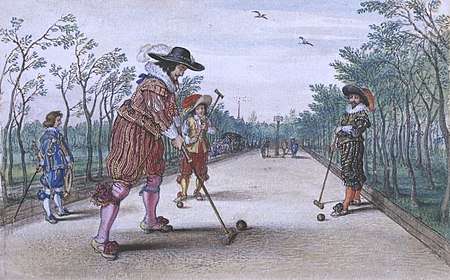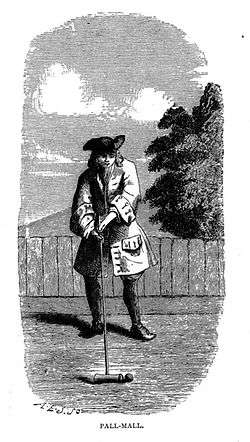Pall-mall
Pall-mall, paille-maille, palle-maille, pell-mell, or palle-malle (UK: /pælˈmæl/, US: /pɛlˈmɛl/, /pælˈmæl/ or /pɔːlˈmɔːl/) is a lawn game that was mostly played in the 16th and 17th centuries,[1] a precursor to croquet.

History
Related to Italian trucco (also known as lawn billiards or trucks in English) and similar games, pall-mall is an early modern development from jeu de mail, a French form of ground billiards.
The name comes from the Italian pallamaglio, which literally means 'ball mallet', ultimately derived from Latin palla, meaning 'ball', and malleus meaning 'maul, hammer, or mallet'.[2] An alternative etymology has been suggested, from Middle French pale-mail or 'straw-mallet', in reference to target hoops being made of bound straw.[3]
History in Britain
It appears that pall mall was introduced from France into Scotland and later to England. The 19th-century historian Henry B. Wheatley states that "pall mall was a popular game in the sixteenth and seventeenth centuries and few large towns were without a mall, or prepared ground, where it could be played; but it has now been so long out of use that no satisfactory account of the game can be found."[4]
Wheatley speculates that the game was introduced to England from Scotland after the accession of James VI in 1603.[4] He bases this on a reference by King James in his 1599 Basilikon Doron to "palle maillé" among the "faire and pleasant field-games" he recommends as suited for his son Henry.[4][5] While the game was evidently present in Scotland in 1599, Wheatley quotes a statement from Robert Dallington as indicating that the game had not yet reached England. In his Method for Travell, which Wheatley dates to 1598 but may have been as late as 1605, Dallington marvels that pall-mall was one of the few French pastimes that had not been introduced to England.[6]
It is known that sometime around 1630 a Frenchman named John Bonnealle laid out a court for playing pall-mall on the south side of St. James's Square, London, in an area known as St. James's Field (later Pall Mall Field). "A year or two" later, in about 1631, Bonnealle had died and the king's shoemaker, David Mallard or Mallock, had built a house on this land, which he was ordered to demolish by Candlemas Day (around 2 February) 1632.[7][8][9]
Evidently, the pall-mall court was rebuilt at this site, as Archibald Lumsden received a grant on 30 September 1635 "for sole furnishing of all the 'Malls,' bowls, scoops, and other necessaries for the game of Pall Mall within his grounds in St. James's Fields, and that such as resort there shall pay him such sums of money as are according to the ancient order of the game."[7][8]
Lumsden's pall-mall court also appears in the records in September 1660, when his daughter Isabella petitioned for "one of the tenements in St. James's Field, as promised to her father who spent £425 14s in keeping the sport of Pall Mall".[8][10] Accounts attached to the petition appeared to indicate the money was spent on "bowls, malls and scopes, 1632 to 1635, and in repairs in Pall Mall, when the Queen went thither to lie in of the Lady Mary."[8][10]

Samuel Pepys's diary for 2 April 1661 records that he went "into St. James's Park, where I saw the Duke of York playing at Pelemele, the first time that I ever saw the sport".[11]
There do not appear to be references earlier than 1630 to the game being played in England. The game is mentioned in a 1611 French-English dictionary, but this does not demonstrate that it was actually played in England at that time:
Palemaille : f. A game, wherein a round box bowle is with a mallet strucke through a high arch of yron (standing at either end of an alley one) which he that can do at the fewest blowes, or at the nu[m]ber agreed on, winnes.
Cotgrave's description of the long alley-like playing surface with an iron hoop at either end accords well with reports of the game as played in London twenty years later. However, there's little reason to read this as an implication that the game was played in England in 1611, especially given that he is providing an English definition of a French word.
An early 19th-century writer on English games, Joseph Strutt, quotes Cotgrave's description and the association with Restoration royalty:
The game of mall was a fashionable amusement in the reign of Charles the Second, and the walk in Saint James's Park, now called the Mall, received its name from having been appropriated to the purpose of playing at mall, where Charles himself and his courtiers frequently exercised themselves in the practice of this pastime. The denomination mall given to the game, is evidently derived from the mallet or wooden hammer used by the players to strike the ball.
The game was still known in the early nineteenth century, as is proved by its reference in many English dictionaries. In Samuel Johnson's 1828 dictionary, his definition of "Pall mall" clearly describes a game with similarities to modern croquet: "A play in which the ball is struck with a mallet through an iron ring".[14] In his unpublished memoir the writer Oswell Blakeston reports seeing it played at "the only pub that still has a green for this game" in the late 1930s.[15]
Game play
It was played in a long alley with an iron hoop suspended over the ground at the end. The object was to strike a boxwood ball of unknown circumference (a modern croquet ball is normally 3 5⁄8 inches (92 mm) in diameter, which equates to approx 11 2⁄5 inches (29 cm), in circumference) with a heavy wooden mallet, down the alley and through the hoop with the fewest hits possible. Many references tell us that the ball was about 12 inches or 30 cm in diameter. However, it is known that this is not correct, as a ball of that size would be far, far too heavy to lift to a high height with a small mallet. Note the ball in the engraving. It is thought that the ball was likely in the region of 2 3⁄4 inches (7 cm) or slightly larger. It differed from trucco especially in its more extreme length of playing area, suggesting a closer relationship to golf than other derivatives of ground billiards.
Pall-mall was popular in Italy, France and Scotland, and spread to England and other parts of Western Europe in the 16th century. The name refers not only to the game, but also to the mallet used and the alley in which it was played. Many cities still have long straight roads or promenades which evolved from the alleys in which the game was played. Such in London are Pall Mall and the Mall, in Hamburg the Palmaille, in Paris the Rue du Mail, the Avenue du Mail in Geneva, and in Utrecht the Maliebaan. When the game fell out of fashion, some of these "pall malls" evolved into shopping areas, hence the modern name of shopping centres in North America—shopping malls[16]—while others evolved into grassed, shady promenades, still called malls today.
References
| Look up pell-mell in Wiktionary, the free dictionary. |
- Jusserand 1901, p. 306.
- Almond 1995.
- Jusserand 1901, p. 308.
- Wheatley 1870, p. 269.
- James VI & I 1611, p. 183.
- Wheatley 1870, pp. 269–270.
- Wheatley 1870, p. 319.
- Fagan 1887, p. 3.
- Bruce 1862, p. 240, No. 68.
- Everett Green 1860, p. 292, No. 41.
- Wheatley 1893.
- Cotgrave 1611.
- Strutt 1810, p. 96.
- Johnson 1828, p. 519.
- https://legacy.lib.utexas.edu/taro/uthrc/00014/hrc-00014.html
- Pocock, Emil. "Mall Definitions". Archived from the original on 7 January 2007.
Sources
- Almond, Jordan (January 1995), Dictionary of Word Origins: A History of the Words, Expressions, and Clichés We Use, Carol Publishing Group, ISBN 978-0-8065-1713-1, retrieved 10 July 2013
- Bruce, John, ed. (1862), Calendar of State Papers, Domestic Series, of the Reign of Charles I, 1631–1633
- Cotgrave, Randle (1611), A Dictionarie of the French and English Tongues, London: Adam Islip
- Everett Green, Mary Anne, ed. (1860), Calendar of State Papers, Domestic Series, of the Reign of Charles II, 1660–1661
- Fagan, Louis (1887), 1836-1886. The Reform Club: Its Founders and Architect, B. Quaritch
- Johnson, Samuel; Walker, John; Jameson, Robert S. (1828), A Dictionary of the English Language, 1 (2 ed.), W. Pickering
- James VI & I (1616) [1599], Basilikon Doron, iii
- Jusserand, J. J. (1996) [1901], Les sports et jeux d'exercice dans l'ancienne France, Paris: self-published
- Strutt, Joseph (1810), The Sports and Pastimes of the People of England
- Wheatley, Henry Benjamin (1870), Round about Piccadilly and Pall Mall, retrieved 11 January 2016
- Henry B. Wheatley, ed. (1893), The Diary of Samuel Pepys M.A. F.R.S., London: George Bell & Sons, available at
